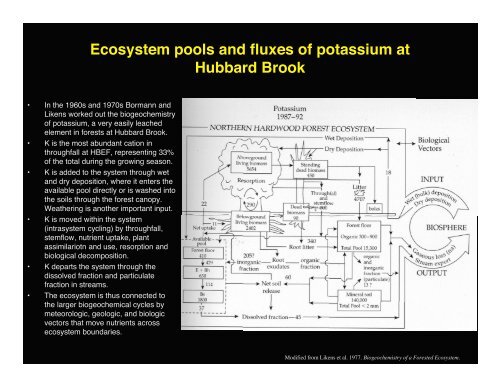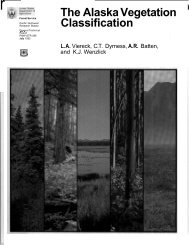Lesson 32 Mineral Cycling - Alaska Geobotany Center
Lesson 32 Mineral Cycling - Alaska Geobotany Center
Lesson 32 Mineral Cycling - Alaska Geobotany Center
Create successful ePaper yourself
Turn your PDF publications into a flip-book with our unique Google optimized e-Paper software.
Ecosystem pools and fluxes of potassium at<br />
Hubbard Brook<br />
• In the 1960s and 1970s Bormann and<br />
Likens worked out the biogeochemistry<br />
of potassium, a very easily leached<br />
element in forests at Hubbard Brook.<br />
• K is the most abundant cation in<br />
throughfall at HBEF, representing 33%<br />
of the total during the growing season.<br />
• K is added to the system through wet<br />
and dry deposition, where it enters the<br />
available pool directly or is washed into<br />
the soils through the forest canopy.<br />
Weathering is another important input.<br />
• K is moved within the system<br />
(intrasystem cycling) by throughfall,<br />
stemflow, nutrient uptake, plant<br />
assimilariotn and use, resorption and<br />
biological decomposition.<br />
• K departs the system through the<br />
dissolved fraction and particulate<br />
fraction in streams.<br />
• The ecosystem is thus connected to<br />
the larger biogeochemical cycles by<br />
meteorologic, geologic, and biologic<br />
vectors that move nutrients across<br />
ecosystem boundaries.<br />
Modified from Likens et al. 1977. Biogeochemistry of a Forested Ecosystem.
















